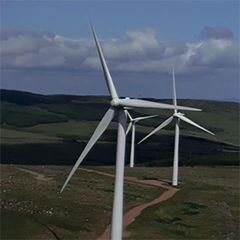Measuring wind farm ‘fuel’ efficiency
Can you name any other energy plant that you build, operate and try to understand if it’s performing efficiently, without actually measuring the fuel that you’re supplying? A wind farm is often exactly that.
According to a recent ‘A Word About Wind’ study, almost 50% of those surveyed placed the validation of their production plant as the Number One priority for them – and currently almost half the interviewed were not confident in what’s actually happening with their asset at any given time.
Until recent years the cost and complexity of measuring with met masts across a wind farm has made this measure of wind farm ‘fuel’, i.e. the wind, impractical. Nacelle or spinner anemometry is given the challenging job of trying to do its best whilst measuring wind behind, or close the rotor and the disturbed air flow. Add to that site complexity, wakes and turbine array effects… it has meant that estimations of wind speed based on rotor speed, power generation or forecasting are often the only choice.
In contrast, Nacelle Based Lidars remotely and precisely measure the wind ahead of a turbine and provide meaningful validations of how wind turbines and wind farms are performing providing information for asset optimisation. In wind farm development Ground Based Lidars have replaced the need for met masts as, according to a recent study by renewable energy company RES, they are ‘safer, cheaper, faster and better’.
Measuring wind farm ‘fuel’ efficiency
Can you name any other energy plant that you build, operate and try to understand if it’s performing efficiently, without actually measuring the fuel that you’re supplying? A wind farm is often exactly that.
According to a recent ‘A Word About Wind’ study, almost 50% of those surveyed placed the validation of their production plant as the Number One priority for them – and currently almost half the interviewed were not confident in what’s actually happening with their asset at any given time.
Until recent years the cost and complexity of measuring with met masts across a wind farm has made this measure of wind farm ‘fuel’, i.e. the wind, impractical. Nacelle or spinner anemometry is given the challenging job of trying to do its best whilst measuring wind behind, or close the rotor and the disturbed air flow. Add to that site complexity, wakes and turbine array effects… it has meant that estimations of wind speed based on rotor speed, power generation or forecasting are often the only choice.
In contrast, Nacelle Based Lidars remotely and precisely measure the wind ahead of a turbine and provide meaningful validations of how wind turbines and wind farms are performing providing information for asset optimisation. In wind farm development Ground Based Lidars have replaced the need for met masts as, according to a recent study by renewable energy company RES, they are ‘safer, cheaper, faster and better’.
To read the full content,
please download the PDF below.















